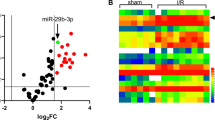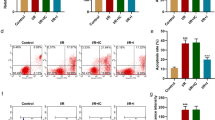Abstract
MicroRNAs (miRNAs) are recognized to hold essential parts in the course of pathophysiology participating in myocardial ischemia/reperfusion (I/R) injury. The current study was intended to appraise the functional implication and underlying regulatory mechanism action of miR-20a in myocardial I/R injury. In cardiomyocyte hypoxia/reoxygenation (H/R) model simulating I/R, we observed that miR-20a was diminished in H9c2 cells subjected to H/R. The miR-20a mimics promoted cardiomyocyte viability and reduced H/R-triggered cell apoptosis, while the miR-20a inhibitors induced the inverse response in H9c2 cells subjected to H/R injury. Moreover, we ascertained that TLR4 was one downstream target gene of miR-20a and revealed that miR-20a might hold its protective action on cardiomyocytes subjected to H/R by inactivating p38 MAPK/JNK signaling. In summary, this study highlighted the relieved potential of miR-20a against cardiomyocyte H/R injury and suggested its favorable therapeutic role for myocardial I/R injury.




Similar content being viewed by others
References
Ameres SL, Zamore PD (2013) Diversifying microRNA sequence and function. Nat Rev Mol Cell Biol 14:475–488
Ao L, Zou N, Cleveland JC Jr, Fullerton DA, Meng X (2009) Myocardial TLR4 is a determinant of neutrophil infiltration after global myocardial ischemia: mediating KC and MCP-1 expression induced by extracellular HSC70. Am J Physiol Heart Circ Physiol 297:H21–H28
Bai Y, Jiang Y, Liu T, Li F, Zhang J, Luo Y, Zhang L, Yan G, Feng Z, Li X, Wang X, Hu W (2019) Xinjiang herbal tea exerts immunomodulatory activity via TLR2/4-mediated MAPK signaling pathways in RAW264.7 cells and prevents cyclophosphamide-induced immunosuppression in mice. J Ethnopharmacol 228:179–187
Bartel DP (2004) MicroRNAs: genomics, biogenesis, mechanism, and function. Cell 116:281–297
Beutler B (2000) Endotoxin, toll-like receptor 4, and the afferent limb of innate immunity. Curr Opin Microbiol 3:23–28
Boehm M, Slack FJ (2006) MicroRNA control of lifespan and metabolism. Cell Cycle 5:837–840
Brightbill HD, Modlin RL (2000) Toll-like receptors: molecular mechanisms of the mammalian immune response. Immunology 101:1–10
Chong AJ, Shimamoto A, Hampton CR, Takayama H, Spring DJ, Rothnie CL, Yada M, Pohlman TH, Verrier ED (2004) Toll-like receptor 4 mediates ischemia/reperfusion injury of the heart. J Thorac Cardiovasc Surg 128:170–179
Das A, Samidurai A, Salloum FN (2018) Deciphering non-coding RNAs in cardiovascular health and disease. Front Cardiovasc Med 5:73
Dong S, Cheng Y, Yang J, Li J, Liu X, Wang X, Wang D, Krall TJ, Delphin ES, Zhang C (2009) MicroRNA expression signature and the role of microRNA-21 in the early phase of acute myocardial infarction. J Biol Chem 284:29514–29525
Dougherty CJ, Kubasiak LA, Prentice H, Andreka P, Bishopric NH, Webster KA (2002) Activation of c-Jun N-terminal kinase promotes survival of cardiac myocytes after oxidative stress. Biochem J 362:561–571
Fallach R, Shainberg A, Avlas O, Fainblut M, Chepurko Y, Porat E, Hochhauser E (2010) Cardiomyocyte Toll-like receptor 4 is involved in heart dysfunction following septic shock or myocardial ischemia. J Mol Cell Cardiol 48:1236–1244
Ferrandi C, Ballerio R, Gaillard P, Giachetti C, Carboni S, Vitte PA, Gotteland JP, Cirillo R (2004) Inhibition of c-Jun N-terminal kinase decreases cardiomyocyte apoptosis and infarct size after myocardial ischemia and reperfusion in anaesthetized rats. Br J Pharmacol 142:953–960
Foo RS, Mani K, Kitsis RN (2005) Death begets failure in the heart. J Clin Invest 115:565–571
Foo RS, Chan LK, Kitsis RN, Bennett MR (2007) Ubiquitination and degradation of the anti-apoptotic protein ARC by MDM2. J Biol Chem 282:5529–5535
Frank D, Gantenberg J, Boomgaarden I, Kuhn C, Will R, Jarr KU, Eden M, Kramer K, Luedde M, Mairbaurl H, Katus HA, Frey N (2012) MicroRNA-20a inhibits stress-induced cardiomyocyte apoptosis involving its novel target Egln3/PHD3. J Mol Cell Cardiol 52:711–717
Fressigne L, Simard MJ (2018) Biogenesis of small non-coding RNAs in animals. Med Sci (Paris) 34:137–144
Gill R, Tsung A, Billiar T (2010) Linking oxidative stress to inflammation: Toll-like receptors. Free Radic Biol Med 48:1121–1132
Ha T, Liu L, Kelley J, Kao R, Williams D, Li C (2011) Toll-like receptors: new players in myocardial ischemia/reperfusion injury. Antioxid Redox Signal 15:1875–1893
Hausenloy DJ, Yellon DM (2013) Myocardial ischemia-reperfusion injury: a neglected therapeutic target. J Clin Invest 123:92–100
Hori M, Nishida K (2009) Oxidative stress and left ventricular remodelling after myocardial infarction. Cardiovasc Res 81:457–464
Hua F, Ha T, Ma J, Li Y, Kelley J, Gao X, Browder IW, Kao RL, Williams DL, Li C (2007) Protection against myocardial ischemia/reperfusion injury in TLR4-deficient mice is mediated through a phosphoinositide 3-kinase-dependent mechanism. J Immunol 178:7317–7324
Li Z, Ma JY, Kerr I, Chakravarty S, Dugar S, Schreiner G, Protter AA (2006) Selective inhibition of p38alpha MAPK improves cardiac function and reduces myocardial apoptosis in rat model of myocardial injury. Am J Physiol Heart Circ Physiol 291:H1972–H1977
Linde A, Mosier D, Blecha F, Melgarejo T (2007) Innate immunity and inflammation--new frontiers in comparative cardiovascular pathology. Cardiovasc Res 73:26–36
Luo F, Shi J, Shi Q, Xu X, Xia Y, He X (2016) Mitogen-activated protein kinases and hypoxic/ischemic nephropathy. Cell Physiol Biochem 39:1051–1067
Mackay K, Mochly-Rosen D (1999) An inhibitor of p38 mitogen-activated protein kinase protects neonatal cardiac myocytes from ischemia. J Biol Chem 274:6272–6279
Makhdoumi P, Roohbakhsh A, Karimi G (2016) MicroRNAs regulate mitochondrial apoptotic pathway in myocardial ischemia-reperfusion-injury. Biomed Pharmacother 84:1635–1644
Milano G, Morel S, Bonny C, Samaja M, von Segesser LK, Nicod P, Vassalli G (2007) A peptide inhibitor of c-Jun NH2-terminal kinase reduces myocardial ischemia-reperfusion injury and infarct size in vivo. Am J Physiol Heart Circ Physiol 292:H1828–H1835
Moens AL, Claeys MJ, Timmermans JP, Vrints CJ (2005) Myocardial ischemia/reperfusion-injury, a clinical view on a complex pathophysiological process. Int J Cardiol 100:179–190
Mutharasan RK, Nagpal V, Ichikawa Y, Ardehali H (2011) microRNA-210 is upregulated in hypoxic cardiomyocytes through Akt- and p53-dependent pathways and exerts cytoprotective effects. Am J Physiol Heart Circ Physiol 301:H1519–H1530
Oyama J, Blais C Jr, Liu X, Pu M, Kobzik L, Kelly RA, Bourcier T (2004) Reduced myocardial ischemia-reperfusion injury in toll-like receptor 4-deficient mice. Circulation 109:784–789
Qian L, Van Laake LW, Huang Y, Liu S, Wendland MF, Srivastava D (2011) miR-24 inhibits apoptosis and represses Bim in mouse cardiomyocytes. J Exp Med 208:549–560
Rose BA, Force T, Wang Y (2010) Mitogen-activated protein kinase signaling in the heart: angels versus demons in a heart-breaking tale. Physiol Rev 90:1507–1546
Sivanantham A, Pattarayan D, Bethunaickan R, Kar A, Mahapatra SK, Thimmulappa RK, Palanichamy R, Rajasekaran S (2018) Tannic acid protects against experimental acute lung injury through downregulation of TLR4 and MAPK. https://doi.org/10.1002/jcp.27383
Sun Y (2009) Myocardial repair/remodelling following infarction: roles of local factors. Cardiovasc Res 81:482–490
Tang Y, Zheng J, Sun Y, Wu Z, Liu Z, Huang G (2009) MicroRNA-1 regulates cardiomyocyte apoptosis by targeting Bcl-2. Int Heart J 50:377–387
Timmers L, Sluijter JP, van Keulen JK, Hoefer IE, Nederhoff MG, Goumans MJ, Doevendans PA, van Echteld CJ, Joles JA, Quax PH, Piek JJ, Pasterkamp G, de Kleijn DP (2008) Toll-like receptor 4 mediates maladaptive left ventricular remodeling and impairs cardiac function after myocardial infarction. Circ Res 102:257–264
Ventura A, Young AG, Winslow MM, Lintault L, Meissner A, Erkeland SJ, Newman J, Bronson RT, Crowley D, Stone JR, Jaenisch R, Sharp PA, Jacks T (2008) Targeted deletion reveals essential and overlapping functions of the miR-17 through 92 family of miRNA clusters. Cell 132:875–886
Vinten-Johansen J (2004) Involvement of neutrophils in the pathogenesis of lethal myocardial reperfusion injury. Cardiovasc Res 61:481–497
Wang D, Wang Y, Ma J, Wang W, Sun B, Zheng T, Wei M, Sun Y (2017) MicroRNA-20a participates in the aerobic exercise-based prevention of coronary artery disease by targeting PTEN. Biomed Pharmacother 95:756–763
Wei G, Guan Y, Yin Y, Duan J, Zhou D, Zhu Y, Quan W, Xi M, Wen A (2013) Anti-inflammatory effect of protocatechuic aldehyde on myocardial ischemia/reperfusion injury in vivo and in vitro. Inflammation 36:592–602
Weinbrenner C, Liu GS, Cohen MV, Downey JM (1997) Phosphorylation of tyrosine 182 of p38 mitogen-activated protein kinase correlates with the protection of preconditioning in the rabbit heart. J Mol Cell Cardiol 29:2383–2391
Xia W, Luo P, Hua P, Ding P, Li C, Xu J (2018) Discovery of a new pterocarpan-type antineuroinflammatory compound from Sophora tonkinensis through suppression of the TLR4/NFkappaB/MAPK signaling pathway with PU.1 as a potential target. https://doi.org/10.1021/acschemneuro.8b00243
Xu C, Lu Y, Pan Z, Chu W, Luo X, Lin H, Xiao J, Shan H, Wang Z, Yang B (2007) The muscle-specific microRNAs miR-1 and miR-133 produce opposing effects on apoptosis by targeting HSP60, HSP70 and caspase-9 in cardiomyocytes. J Cell Sci 120:3045–3052
Ye Y, Perez-Polo JR, Qian J, Birnbaum Y (2011) The role of microRNA in modulating myocardial ischemia-reperfusion injury. Physiol Genomics 43:534–542
Yellon DM, Hausenloy DJ (2007) Myocardial reperfusion injury. N Engl J Med 357:1121–1135
Yin T, Sandhu G, Wolfgang CD, Burrier A, Webb RL, Rigel DF, Hai T, Whelan J (1997) Tissue-specific pattern of stress kinase activation in ischemic/reperfused heart and kidney. J Biol Chem 272:19943–19950
Zhou M, Cai J, Tang Y, Zhao Q (2013) MiR-17-92 cluster is a novel regulatory gene of cardiac ischemic/reperfusion injury. Med Hypotheses 81:108–110
Zhu H, Fan GC (2012) Role of microRNAs in the reperfused myocardium towards post-infarct remodelling. Cardiovasc Res 94:284–292
Author information
Authors and Affiliations
Contributions
XYG designed this study, directed all the experiments and wrote and revised the manuscript. YZ performed experiments, analyzed related data, and made figures. All authors have reviewed and agreed the manuscript.
Corresponding author
Additional information
Editor: Tetsuji Okamoto
Rights and permissions
About this article
Cite this article
Gong, XY., Zhang, Y. Protective effect of miR-20a against hypoxia/reoxygenation treatment on cardiomyocytes cell viability and cell apoptosis by targeting TLR4 and inhibiting p38 MAPK/JNK signaling. In Vitro Cell.Dev.Biol.-Animal 55, 793–800 (2019). https://doi.org/10.1007/s11626-019-00399-4
Received:
Accepted:
Published:
Issue Date:
DOI: https://doi.org/10.1007/s11626-019-00399-4




